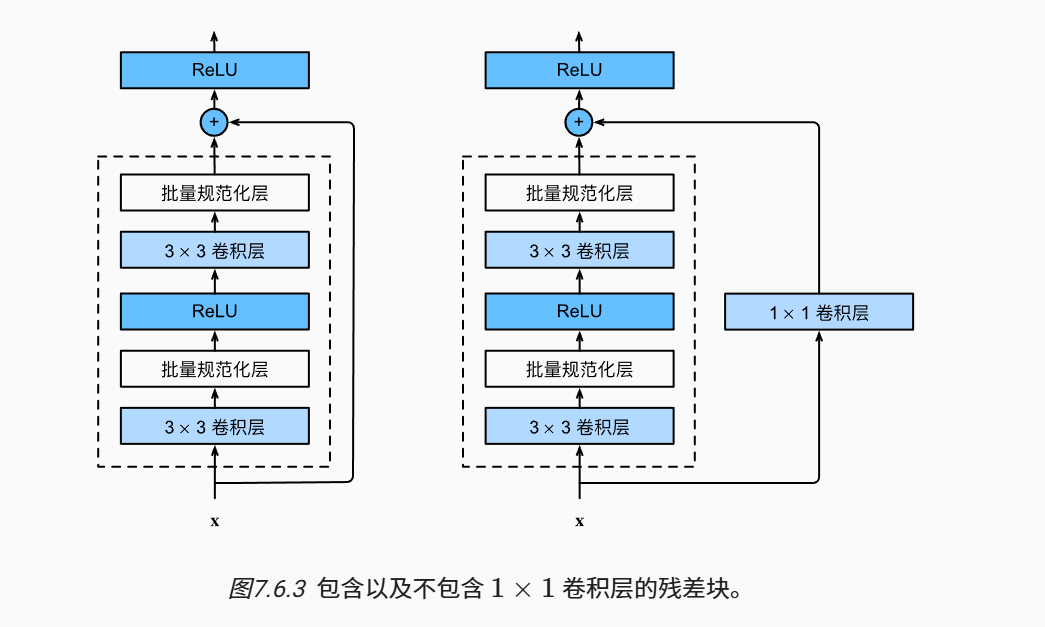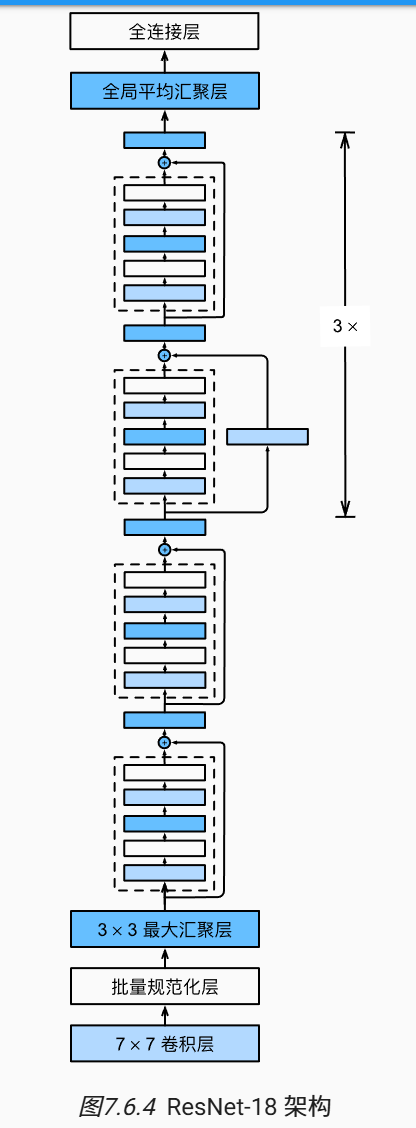ResNet网络
ResNet网络
一.手写ResNet网络
(1)对于残差块有两种:
1.有1*1卷积层
Y=Y+conv_1x1(X)
2.无1*1卷积层
Y=Y+X

(2)整体ResNet架构

import torch
from d2l import torch as d2l
from torch import nn
from torch.nn import functional as F
#1.单个ResNet块(残差块)
class Residual(nn.Module):#每个残差快包含两个卷积层
def __init__(self,in_chanels,out_chanels,use_1x1convd=False,strides=1):
super().__init__()
if use_1x1convd==True:#用了1*1卷积层
self.conv1x1=nn.Conv2d(in_chanels,out_chanels,1,stride=strides)
else:
self.conv1x1 =None#没用1*1卷积层
#卷积层
self.convd1=nn.Conv2d(in_chanels,out_chanels,3,padding=1,stride=strides)
self.convd2=nn.Conv2d(out_chanels,out_chanels,3,padding=1)
#批量归一化层
self.bn1=nn.BatchNorm2d(out_chanels)
self.bn2=nn.BatchNorm2d(out_chanels)
def forward(self,X):#前向函数
Y=F.relu(self.bn1(self.convd1(X)))
Y=self.bn2(self.convd2(Y))
if self.conv1x1 is not None:
X=self.conv1x1(X)
Y=Y+X
return F.relu(Y)
#ResNet网络构造(有5个stage)
b1=nn.Sequential(
nn.Conv2d(1,64,7,2,3),
nn.BatchNorm2d(64),
nn.ReLU(),
nn.MaxPool2d(3,2,1)
)
#多个残差块连接
def resnet_block(in_chanels,outchanels,num_residuals,first_block=False):#残差块数
blk=[]
for i in range(num_residuals):
if i==0 and first_block==False:#通道数*2,高宽减半
blk.append(Residual(in_chanels,outchanels,use_1x1convd=True,strides=2))
else:
blk.append(Residual(outchanels,outchanels))#通道数不变,高宽不变
return blk
b2=nn.Sequential(
*resnet_block(64,64,2,first_block=True)#通道数不变,高宽不变
)
#下面几步的第一块都要通道数*2
b3=nn.Sequential(
*resnet_block(64,128,2)
)
b4=nn.Sequential(
*resnet_block(128,256,2 )
)
b5=nn.Sequential(
*resnet_block(256,512,2)
)
net=nn.Sequential(
b1,b2,b3,b4,b5,
nn.AdaptiveAvgPool2d((1,1)),#表示输出特征图的空间尺寸为 1x1(即高 = 1,宽 = 1)。例如:若输入是 (512, 7, 7)(通道数 = 512,高 = 7,宽 = 7),经过该层后会输出 (512, 1, 1)。若输入是 (512, 14, 14),输出仍为 (512, 1, 1)。
nn.Flatten(),
nn.Linear(512,10)
)
X=torch.rand((1,1,224,224))
for layer in net:
X=layer(X)
print(layer.__class__.__name__,X.shape)二.训练ResNet网络
import torch
from d2l import torch as d2l
from torch import nn
from torch.nn import functional as F
#1.单个ResNet块(残差块)
class Residual(nn.Module):
def __init__(self,in_chanels,out_chanels,use_1x1convd=False,strides=1):
super().__init__()
if use_1x1convd==True:#用了1*1卷积层
self.conv1x1=nn.Conv2d(in_chanels,out_chanels,1,stride=strides)
else:
self.conv1x1 =None
#卷积层
self.convd1=nn.Conv2d(in_chanels,out_chanels,3,padding=1,stride=strides)
self.convd2=nn.Conv2d(out_chanels,out_chanels,3,padding=1)
#批量归一化层
self.bn1=nn.BatchNorm2d(out_chanels)
self.bn2=nn.BatchNorm2d(out_chanels)
def forward(self,X):#前向函数
Y=F.relu(self.bn1(self.convd1(X)))
Y=self.bn2(self.convd2(Y))
if self.conv1x1 is not None:
X=self.conv1x1(X)
Y=Y+X
return F.relu(Y)
#ResNet网络构造(有5个stage)
b1=nn.Sequential(
nn.Conv2d(1,64,7,2,3),
nn.BatchNorm2d(64),
nn.ReLU(),
nn.MaxPool2d(3,2,1)
)
#多个残差快连接
def resnet_block(in_chanels,outchanels,num_residuals,first_block=False):
blk=[]
for i in range(num_residuals):
if i==0 and first_block==False:#通道数*2,高宽减半
blk.append(Residual(in_chanels,outchanels,use_1x1convd=True,strides=2))
else:
blk.append(Residual(outchanels,outchanels))
return blk
b2=nn.Sequential(
*resnet_block(64,64,2,first_block=True)
)
b3=nn.Sequential(
*resnet_block(64,128,2)
)
b4=nn.Sequential(
*resnet_block(128,256,2 )
)
b5=nn.Sequential(
*resnet_block(256,512,2)
)
net=nn.Sequential(
b1,b2,b3,b4,b5,
nn.AdaptiveAvgPool2d((1,1)),
nn.Flatten(),
nn.Linear(512,10)
)
train_iter,test_iter=d2l.load_data_fashion_mnist(256,resize=96)
d2l.train_ch6(net,train_iter,test_iter,10,1,d2l.try_gpu())



 浙公网安备 33010602011771号
浙公网安备 33010602011771号